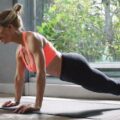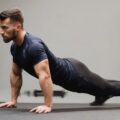Understanding Tricep Strength in Women
When we think of fitness and strength, it’s easy to focus on the more visible muscle groups like abs, legs, and biceps. However, one often overlooked area that many women, even those who are generally fit, struggle with is tricep strength. The triceps, located at the back of the upper arm, play a crucial role in our daily activities and overall upper body strength. Yet, many women find themselves with weaker triceps compared to other muscle groups, regardless of their overall fitness level.
This phenomenon isn’t a reflection of a woman’s dedication to fitness or her capabilities. Rather, it’s a common occurrence that stems from a variety of factors, including natural physiology, exercise habits, and sometimes, misconceptions about strength training. Understanding this can be the first step towards a more balanced and comprehensive approach to fitness.
The Importance of Strong Triceps
Triceps aren’t just about aesthetics or being able to do impressive push-ups. These muscles play a vital role in many everyday activities:
- Pushing doors open
- Lifting objects overhead
- Supporting your body weight in various positions
- Maintaining good posture
- Preventing injuries in other areas of the body
Strong triceps contribute to overall upper body strength and can improve performance in various sports and fitness activities. They’re also crucial for maintaining independence and quality of life as we age, helping us perform daily tasks with ease.
Why Women Often Have Weaker Triceps
Several factors contribute to the common occurrence of weaker triceps in women:
- Hormonal differences: Women naturally have lower levels of testosterone, which can make it more challenging to build upper body strength.
- Exercise habits: Many women focus more on lower body exercises or cardio, potentially neglecting upper body strength training.
- Misconceptions about strength training: Some women may avoid heavy lifting due to fears of becoming “bulky,” missing out on the benefits of resistance training.
- Natural body composition: Women tend to carry more body fat in their upper arms, which can mask muscle definition.
- Lack of specific tricep training: Many common exercises don’t target the triceps effectively.
Understanding these factors isn’t about making excuses, but rather about recognizing the unique challenges women may face and addressing them constructively.
Effective Tricep Exercises for Women
The good news is that with targeted exercises and consistent effort, women can significantly improve their tricep strength. Here are some effective exercises to incorporate into your routine:
- Tricep Dips: These can be done using a chair, bench, or dip station.
- Overhead Tricep Extensions: Use a dumbbell or resistance band for this effective isolation exercise.
- Close-Grip Push-Ups: A variation of the standard push-up that targets the triceps more directly.
- Diamond Push-Ups: An advanced variation that really hones in on the triceps.
- Tricep Kickbacks: A great exercise for targeting the long head of the triceps.
Remember, the key is consistency and proper form. Start with lighter weights or modifications and gradually increase the difficulty as you build strength.
Embracing Strength: A Holistic Approach
While focusing on tricep strength is important, it’s equally crucial to approach fitness and strength training holistically. This means:
- Balanced workouts that target all major muscle groups
- Incorporating both strength training and cardiovascular exercise
- Paying attention to nutrition and recovery
- Setting realistic goals and celebrating progress
- Listening to your body and adjusting your routine as needed
Remember, strength isn’t just about muscle size or the ability to lift heavy weights. It’s about feeling confident, capable, and healthy in your own body. Every woman’s fitness journey is unique, and what matters most is finding an approach that works for you and makes you feel good.
Overcoming Mental Barriers
Often, the biggest obstacles to improving strength are mental rather than physical. Many women face self-doubt, fear of judgment, or misconceptions about strength training. Here are some tips to overcome these barriers:
- Educate yourself: Learn about the benefits of strength training and dispel any myths you may have heard.
- Start small: Begin with exercises you’re comfortable with and gradually challenge yourself.
- Find a supportive community: Surround yourself with people who encourage and motivate you.
- Focus on progress, not perfection: Celebrate small improvements and be patient with yourself.
- Remember why you started: Keep your health and well-being goals in mind to stay motivated.
Building strength, including in your triceps, is a journey. It’s not about comparing yourself to others or achieving a certain look. It’s about becoming the strongest, healthiest version of yourself.
FAQ: Common Questions About Women’s Tricep Strength
1. Will working on my triceps make my arms look bulky?
No, building tricep strength won’t make your arms bulky. Women naturally have lower testosterone levels, making it difficult to build large muscles. Strengthening your triceps will help tone and define your arms.
2. How often should I train my triceps?
Aim to include tricep exercises in your routine 2-3 times a week, allowing at least one day of rest between sessions for muscle recovery.
3. Can I improve my tricep strength without going to the gym?
Absolutely! Many effective tricep exercises can be done at home using bodyweight, resistance bands, or household items like water bottles or cans.
4. Why are push-ups so challenging for many women?
Push-ups require significant upper body strength, including in the triceps. Many women find them challenging due to naturally lower upper body strength and less focus on these muscles in typical workout routines.
5. How long will it take to see improvements in my tricep strength?
With consistent training, you may start to feel stronger within a few weeks. Visible changes typically take longer, often 8-12 weeks or more, depending on factors like diet, exercise frequency, and individual physiology.
Remember, building strength is a journey, not a destination. Be patient with yourself, stay consistent, and celebrate every bit of progress along the way. Your body is capable of amazing things, and with time and effort, you’ll be surprised at what you can achieve!









